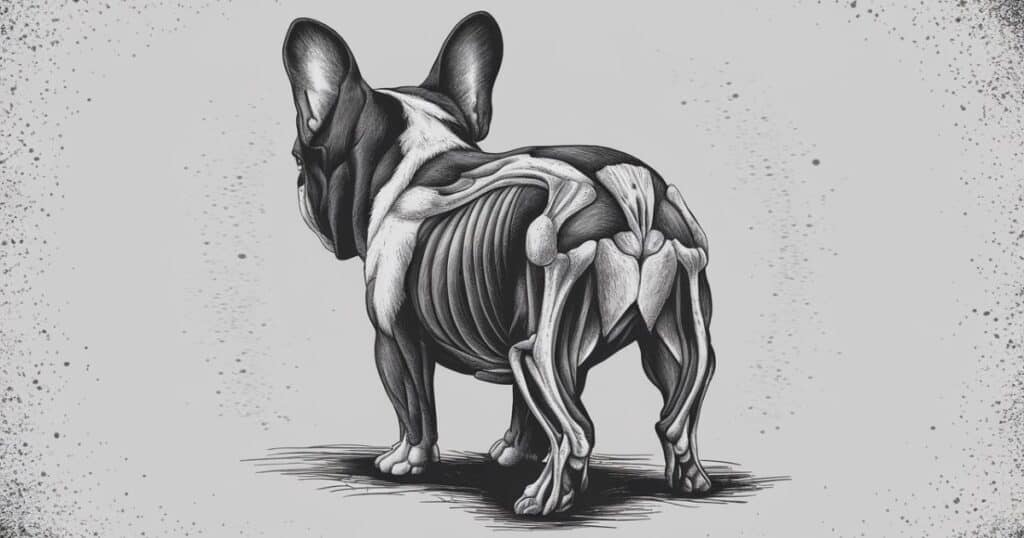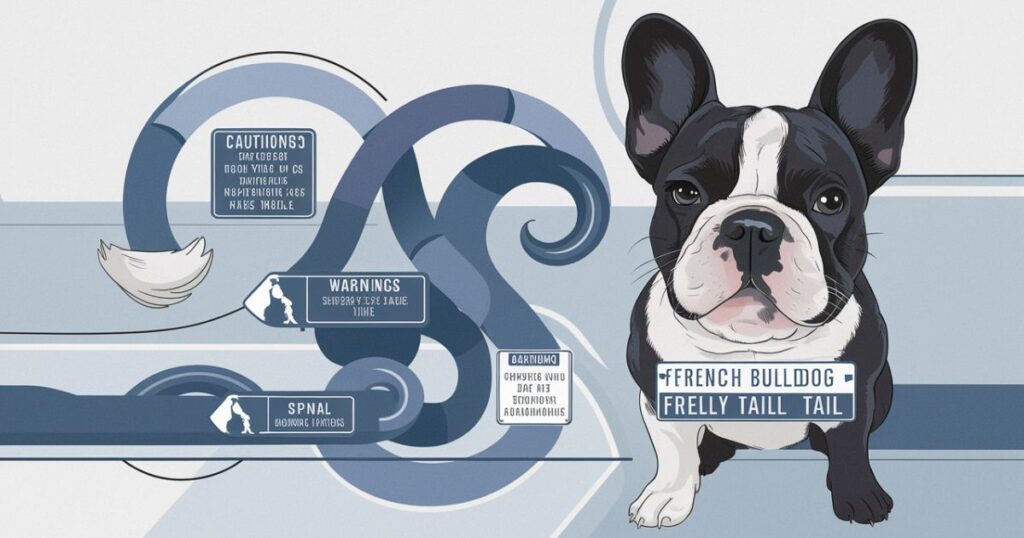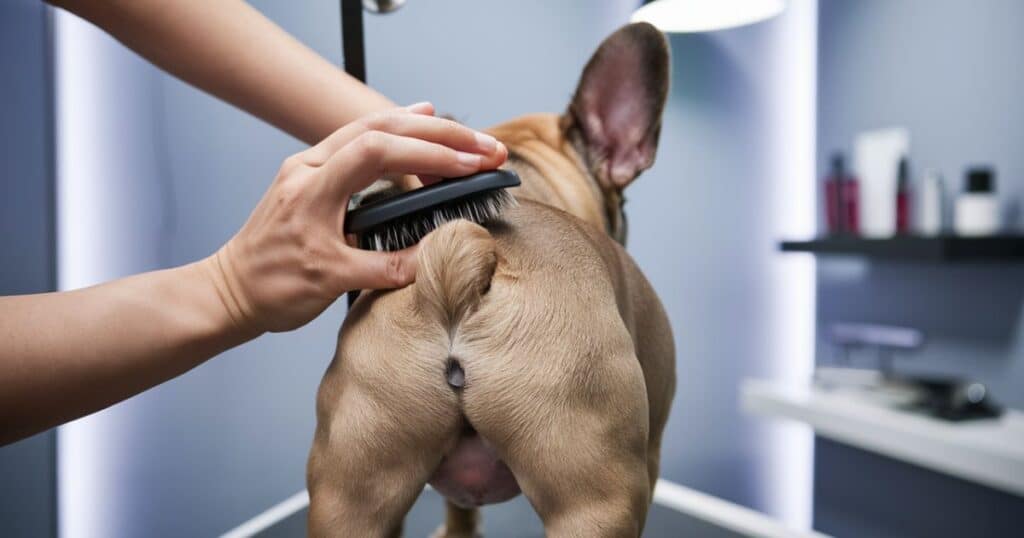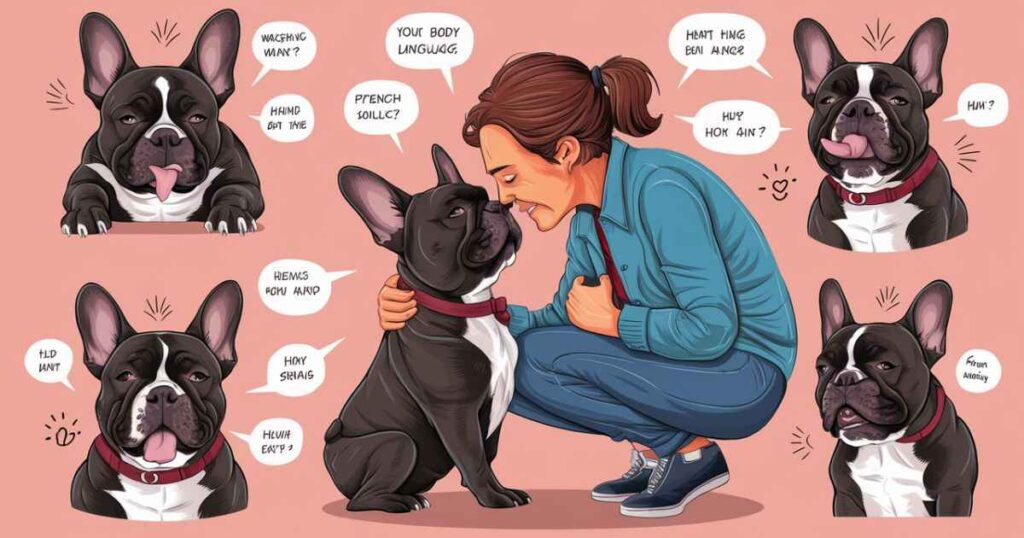Our team meticulously researches, tests, and evaluates products and services, drawing from our personal experiences and expertise, all while adhering to our rigorous review guidelines. Should you choose to make a purchase through our provided links, we may earn a commission at no extra cost to you.
French Bulldogs hold an undeniable charm and are widely adored for their trademark bat ears, compact physique, and lovable temperaments. Yet, among their many endearing traits, one aspect often piques curiosity and invites misconceptions: their unique tails.
Whether you’re a seasoned owner of these delightful pups or embarking on your journey with the breed, grasping the intricacies of the French Bulldog tail is vital for their overall well-being and joy.
In this blog post, we’ll uncover the truth about French Bulldog tails, dispelling common myths and delving into their anatomy. We’ll also address tail-related health issues, provide guidance on proper care, and navigate the ongoing discourse surrounding tail docking. Furthermore, we’ll compare the tails of French Bulldogs with those of other breeds, offering a comprehensive insight into this captivating breed characteristic.
Key Takeaways
- French Bulldogs possess naturally short tails as a result of a genetic mutation, which can exhibit variations in length and shape, yet they maintain optimal health.
- Consistent inspection, cleaning, and safeguarding from sunburn are imperative to uphold the well-being of a French Bulldog’s tail.
- Ethical breeders prioritize breeding with naturally short-tailed individuals to uphold the breed’s unique traits.
- Monitoring their body language is crucial for understanding the emotions, needs, and intentions of French Bulldogs, contributing to their overall welfare.
- Contrasting them with other breeds aids in recognizing and appreciating their distinct characteristics.
The Truth About French Bulldog Tails

Contrary to a common misconception, it’s important to note that French Bulldogs do indeed have tails, albeit short ones. The misconception stems from the fact that their tails are naturally shorter compared to other breeds. This characteristic is not a result of a complete absence of tails, but rather a deliberate outcome of selective breeding practices aimed at accentuating their compact bodies and distinctive facial features.
At birth, French Bulldogs do possess tails, albeit naturally shorter ones. The length can vary slightly among individual pups. These naturally short tails are integral to the breed’s identity and contribute significantly to their overall allure. By grasping the genetic rationale behind their abbreviated tails, one can debunk the erroneous belief that French Bulldogs lack tails entirely.
Misconception: French Bulldogs Have No Tails
Contrary to a common misconception, French Bulldogs are not entirely tailless. While their tails are notably short, they do exist and play a significant role. The abbreviated tails of Frenchies are a result of careful breeding practices aimed at accentuating specific physical characteristics, such as their compact bodies and distinctive facial features.
At birth, French Bulldogs do indeed have tails, though naturally short. The length of these tails can vary from pup to pup, but their inherently brief nature is a hallmark trait of the breed, adding to their allure and individuality. By understanding the genetic underpinnings behind their truncated tails, we can debunk the misconception that French Bulldogs lack tails altogether.
Misconception: French Bulldog Tails Are Always Docked
Contrary to a common misconception, not all French Bulldogs undergo tail docking, a procedure where their tails are surgically shortened. While some breeders opt for this practice, it’s important to note that many French Bulldogs naturally have short tails due to their breeding history. Tail docking, which remains a contentious issue, is often deemed unnecessary and even inhumane by certain individuals.
The reality is that the vast majority of French Bulldogs are born with naturally short, stubby tails. Although there might be slight variations in tail length and shape among individual dogs, the short tails characteristic of French Bulldogs primarily stem from their genetics, rather than being a direct result of tail docking.
The Anatomy of a French Bulldog’s Tail

Now that we’ve cleared up a few misunderstandings about French Bulldog tails, let’s take a closer look at their anatomy. French Bulldogs typically have one of two types of tails: straight or screw. Each type comes with its own set of distinct features and can vary in appearance among different dogs.
Understanding your French Bulldog’s tail structure is crucial for recognizing any potential health issues and providing appropriate care. It also helps you to fully grasp the breed’s individuality and the characteristics that make them so beloved among dog enthusiasts.
Straight Tails
French bulldogs boast tails that exhibit distinctive traits:
- Short in length
- Smooth in texture
- Generally straight
- Often held low
- Beginning thick at the base and gradually tapering to a point
The American Kennel Club (AKC) holds a preference for straight tails in French Bulldogs, aligning with breed standards. However, it’s essential to recognize the uniqueness of each Frenchie; tail shapes may vary among individuals. Responsible owners prioritize celebrating their dog’s individuality while staying mindful of any tail-related health considerations.
Screw Tails
Spiral tails in French Bulldogs, commonly referred to as screw tails, are a distinctive feature where the tail curls tightly in a spiral or corkscrew shape. This trait, also known as an ingrown tail or corkscrew tail, is inherited and can be seen in other brachycephalic breeds like Pugs and Boston Terriers. Unfortunately, screw tails can lead to discomfort and require special care and attention.
It’s estimated that around 10% of French Bulldogs possess screw tails, also affectionately called Frenchie tails. If your Frenchie exhibits this trait, it’s crucial to monitor their health closely, regularly checking their tail for any signs of irritation or infection. Proper care for French Bulldogs with screw tails involves consistent examination and hygiene practices, along with protection against sunburn.
Health Concerns Related to French Bulldog Tails

While the adorable stubby tails of French Bulldogs contribute to their undeniable appeal, they also come with certain health considerations. Understanding these concerns is crucial for ensuring optimal care for your cherished Frenchie.
Among the frequently cited health issues linked to French Bulldog tails are hemivertebrae and tail pocket infections. These conditions often stem from the distinctive structure of the breed’s tail, underscoring the need for attentive and specialized care to safeguard your Frenchie’s health and happiness.
Hemivertebrae
Hemivertebrae manifests as an abnormality in the vertebrae of the spine, posing risks of spinal and nerve complications. This condition particularly affects French Bulldogs with screw tails, potentially leading to mobility issues and incontinence.
Symptoms of Hemivertebrae in French Bulldogs, as reported by French Bulldog Saviors:
- Suspected hemivertebrae warrants prompt veterinary consultation to evaluate and recommend suitable treatment options.
- Treatment modalities may encompass massage therapy, physiotherapy, and in some instances, corrective surgical intervention.
- Consistent veterinary check-ups and vigilant monitoring are indispensable for safeguarding the overall well-being of your beloved Frenchie.
Tail Pocket Infections
Tail pocket infections are another common health concern related to French Bulldog tails. These infections can occur when the skin folds surrounding the tail become irritated or infected, resulting in swelling, redness, and itchiness.
To treat a tail pocket infection, it’s essential to consult with a veterinarian as soon as possible. They will likely:
- Clean the area
- Provide you with topical medication for continued cleaning over the next few weeks
- Prescribe oral antibiotics and antifungal medications, depending on the nature of the infection
Regular inspection and cleaning of your French Bulldog’s tail, tail pocket, and tail pockets can help prevent infections and maintain overall health.
Proper Care for Your French Bulldog’s Tail

Ensuring optimal care for your French Bulldog’s tail is crucial for their holistic health and happiness. Consistent examination and hygiene practices are vital in averting infections and preserving your Frenchie’s tail’s well-being. Moreover, shielding their tail from sun damage is a fundamental component of tail maintenance. By staying vigilant about potential health issues and implementing appropriate care measures, you can contribute to your French Bulldog’s enduring joy, vitality, and contentment.
Regular Inspection and Cleaning
Regular maintenance of your French Bulldog’s tail and tail pocket is crucial for warding off infections and ensuring their well-being stays tip-top. When you’re giving them some grooming love or cozy cuddles, take a moment to give their tail area a once-over for any signs of trouble like redness, swelling, or irritation. Should any issues crop up, it’s best to loop in your vet for the proper care and treatment.
To keep that tail pocket pristine, opt for neutral wipes followed by a gentle drying with a soft, clean cloth. By keeping this area clean and dry, you’re not just preventing bacterial infections, but you’re also keeping your Frenchie feeling comfy and in the pink of health.
Preventing Sunburn
Because of their brief length and absence of fur, French Bulldog tails are prone to sunburn. To safeguard your Frenchie’s tail from this discomfort, it’s vital to control their exposure to sunlight and apply sunscreen formulated for dogs when needed. By ensuring your French Bulldog’s tail remains shaded and shielded from direct sunlight, you can mitigate the risk of painful sunburns, promoting their comfort and overall well-being. Taking care of your Frenchie’s tail is a crucial component of responsible pet ownership, contributing to their health and happiness.
Breeding Considerations for French Bulldogs

Breeding considerations play a significant role in preserving the distinct characteristics of French Bulldogs and securing the health of generations to come. Responsible breeders should be aware of breed standards, such as tail length and shape, and strive to maintain these standards when selecting breeding partners.
The debate over tail docking in French Bulldogs is a contentious issue, with arguments both for and against the practice. As a potential Frenchie owner or breeder, it’s essential to educate yourself on the various viewpoints and make informed decisions regarding the care and breeding of these beloved dogs.
Preserving Breed Standards
Ensuring the preservation of breed standards in French Bulldogs stands as a pivotal priority for a multitude of compelling reasons. It encompasses the safeguarding of the breed’s distinctive attributes, temperament, and physical presentation. It is incumbent upon conscientious breeders to steer clear of mating dogs with elongated tails, as this could yield offspring deviating from the norm, potentially encountering health complications associated with their tails.
The American Kennel Club (AKC) unequivocally opposes tail docking, a sentiment echoed by numerous nations where the practice has been outlawed outright. By directing their efforts towards the propagation of French Bulldogs endowed with naturally abbreviated tails, breeders actively contribute to the perpetuation of the breed’s unique aesthetic and uphold the health and vitality of forthcoming lineages.
The Debate Over Tail Docking
The discourse surrounding tail docking in French Bulldogs remains a hotly debated topic, stirring up passionate arguments from both sides. Advocates of tail docking assert its role in maintaining breed standards and averting potential tail-related ailments such as injuries and infections. Conversely, critics condemn it as an unnecessary and inhumane procedure that inflicts pain and distress upon the canine.
For individuals considering ownership or breeding of French Bulldogs, delving into the diverse perspectives on tail docking is imperative. Making well-informed choices concerning the welfare and breeding practices of these beloved companions hinges upon this understanding. Ultimately, the responsibility of whether to dock or preserve the tail of a French Bulldog rests squarely on the shoulders of the owner, guided by a commitment to the dog’s welfare and the preservation of the breed’s integrity.
Recognizing Your French Bulldog’s Body Language

Understanding your French Bulldog’s body language can offer insights into potential health concerns. Frenchies, with their distinctive short tails, may not wag as visibly as other breeds, making it crucial to observe other cues for clues about their well-being.
Expressions of joy in French Bulldogs can vary; some may wag their entire rear end, while others might exhibit relaxation through a loose posture, relaxed mouth, and gentle gaze. By closely observing your Frenchie’s body language, you can grasp their emotions and provide appropriate care, training, and socialization, ensuring their overall happiness and health. Paying attention to how French Bulldogs wag can deepen your bond with your furry companion.
Comparing French Bulldog Tails to Other Breeds
While each breed boasts its own distinctive tail length and appearance, delving into the comparison between French Bulldog tails and those of other breeds offers a captivating glimpse into the intricate interplay of genetics in tail development. Among the ranks of similarly endowed canines stand the likes of Boston Terriers, English Bulldogs, and Boxers, all sporting naturally truncated tails owing to akin genetic mutations.
Unraveling the genetic underpinnings behind the abbreviated tails of French Bulldogs and their counterparts serves to debunk any prevailing misconceptions while nurturing a heightened admiration for these cherished canines’ unique attributes. For aficionados and guardians of the French Bulldog breed, delving into the intricacies of their distinctive tail traits promises to enrich their comprehension of the breed’s legacy and enthralling narrative.
Summary
In summary, French Bulldog tails stand out as a captivating and distinctive trait cherished by dog enthusiasts globally. By dispelling prevalent myths, comprehending their physiology, and recognizing potential health issues, you can safeguard the well-being and contentment of your beloved Frenchie.
Always bear in mind, as a French Bulldog guardian, embracing your pup’s uniqueness is paramount, alongside offering the essential care and devotion for their optimal growth. Such dedication will yield the priceless bond and companionship of one of the most enchanting and captivating canine breeds.
Frequently Asked Questions
Are French Bulldogs typically born with tails?
Yes, it’s quite common for French Bulldogs to have tails, albeit usually short. So, if your French bulldog puppy sports a petite tail, it’s perfectly normal.
What should the tail of a French Bulldog ideally look like?
A French Bulldog’s tail should be short with a distinctive corkscrew shape, hanging low, boasting a thick root and fine tip. It shouldn’t be curly. Historically, Frenchies naturally had this tail shape, and docking is unnecessary.
Why were French Bulldog tails docked historically?
In the past, French Bulldogs were utilized for dog fights and bull baitings, prompting tail docking to prevent injuries. Over time, selective breeding led to naturally shorter and thicker tails.
What are some health concerns associated with French Bulldog tails?
French Bulldog tails may be susceptible to health issues like hemivertebrae and tail pocket infections. Therefore, it’s crucial to be vigilant about their care and health.
How can I ensure proper care for my French Bulldog’s tail?
Regularly examine and cleanse your French Bulldog’s tail, and make sure it’s adequately shielded from sunburn. These simple steps contribute to their overall well-being.







1 thought on “Debunking Myths: The Truth About the French Bulldog Tail”